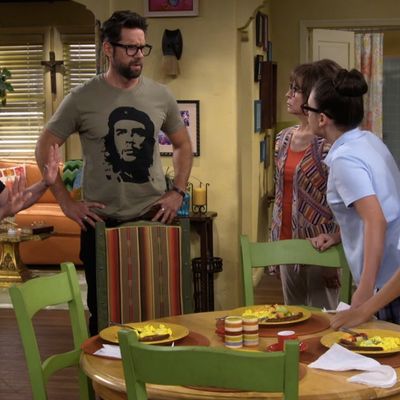
Cultural details are sprinkled throughout NetflixÔÇÖs One Day at a Time. AbuelitaÔÇÖs cafetera (coffee maker) and her salsa-playing alarm, the quince├▒aera photo album, PenelopeÔÇÖs guayabera shirt, and even Echo Park, where the Cuban-American family lives. But there is perhaps no moment more Cuban than when neighbor and landlord Schneider walks into the Alvarez familyÔÇÖs apartment sporting a Che Guevara T-shirt.
ÔÇ£Do you have any idea what this┬ácome mierda┬ádid?ÔÇØ┬á In one line, Penelope (Justina Machado)┬ácalls Schneider (Todd Grinnell) out for unknowingly offending the family and uses one of the most popular curse words in Cuban Spanish to do so. (Literally,┬ácome mierda┬átranslates to ÔÇ£shit-eater,ÔÇØ but its actual meaning is closer to something worse than asshole.)
ÔÇ£Viva la revoluci├│n!ÔÇØ Schneider cluelessly says.┬á As Penelope ÔÇö and the rest of the family informs him ÔÇö this is akin to him wearing a shirt with HitlerÔÇÖs image on it in a Jewish familyÔÇÖs home. The polarizing Argentine Marxist revolutionary served as Fidel CastroÔÇÖs second-in-command during the revolution that toppled the Cuban government in 1959. ÔÇ£He burned books, personally he banned music, he personally oversaw executions, heÔÇÖs a mass murderer!ÔÇØ adds the 14-year-old Elena (Isabella Gomez). After Guevara left Cuba and was executed in Bolivia in 1967, he gained a martyr-like status in some countries, which explains the popularity of his image.
But never for Cuban exiles.
ÔÇ£We live in a world where people can have opinions and spread things about something they donÔÇÖt know anything about,ÔÇØ says co-showrunner Gloria Calderon Kellett, whose own family is the foundation for the revival of Norman LearÔÇÖs ÔÇÿ70s hit show. ÔÇ£There is a danger to that, and it seems like such a ripe opportunity for us to laugh and make fun of something but also talk about something real. You see these shirts a lot. ItÔÇÖs interesting that people are putting things on their bodies without knowing what it represents.ÔÇØ
In cities like Los Angeles, Che Guevera merchandise is everywhere. Calderon Kellett wanted to address that in the show because of something that occurred when she and a friend stopped at a Cuban coffee shop, and El Che shirts were on sale.
ÔÇ£My friend went off on the owner or attendant: ÔÇÿWhat the hell? YouÔÇÖre not Cuban obviously!ÔÇÖÔÇØ she recalls him saying. ÔÇ£It was so empowering to be standing there and seeing this man who is so smart and articulate break it down, because when I see these things, I get so emotional that I shut down. When we were doing the show, somebody made a joke at some point that made me think,┬áHow could we not touch on this?ÔÇØ
The scene is the cold open of ÔÇ£Viva Cuba,ÔÇØ the poignant ninth episode, which reveals that abuelita (Rita Moreno) left Cuba under Operation Pedro Pan, a program that provided safe haven in the United States for children without their families. (About 14,000 children left Cuba under the program.) ÔÇ£The character of Schneider is one of those well-meaning bobos so we decided that, especially for the episode that ends up being about Cuba from a different point of view, weÔÇÖd start off with this,ÔÇØ Calderon Kellett explained.
Even some of the writers working on the show were surprised to learn how Cubans react to mentions of Che Guevera. ÔÇ£So many of them did not know!ÔÇØ Calderon Kellett said. ÔÇ£In fact, we watched a lot of videos online and there were was one where some teachers were on strike and they were wearing Che Guevara T-shirts. And somebody asked them if they know what that means and they said, ÔÇÿYeah, revolution!ÔÇÖÔÇØ

